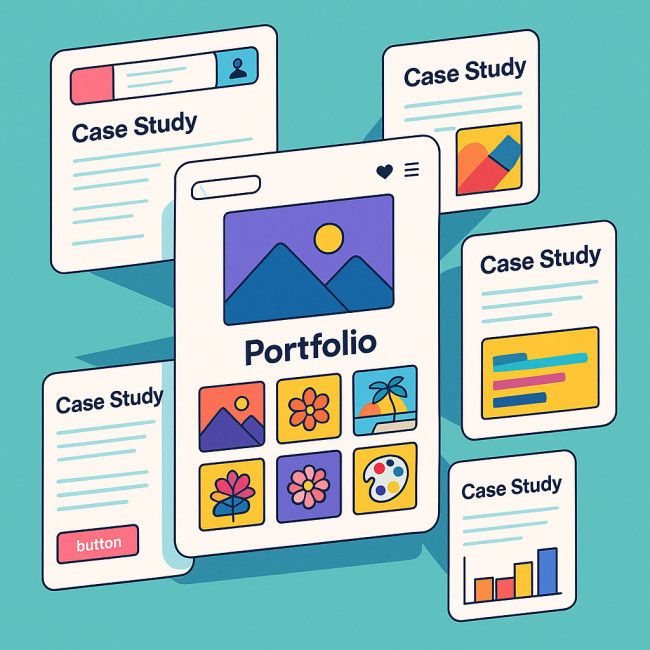Case studies vs galleries: choosing the best format for a portfolio relaunch
Relaunching a creative portfolio forces a crucial decision: do you showcase work through in-depth case studies or a fast-scrolling gallery? Each format shapes how recruiters perceive your expertise, process and potential fit. This guide compares both options, offers a hybrid roadmap and helps you pick the structure that maximises visibility, engagement and conversions during your portfolio relaunch.
Why the format question matters in a portfolio relaunch
Recruiters make snap judgements—often in under 20 seconds. Your chosen format influences:
- Search discoverability—word-rich case studies rank for long-tail queries, while alt-tagged gallery images surface in visual search.
- Engagement depth—narratives hold attention; rapid grids encourage scanning and bookmarking.
- Lead quality—detailed context attracts problem-solving briefs; quick visuals lure style-first projects.
Quick-glance comparison
| Criteria | Case studies | Image galleries |
|---|---|---|
| User attention span | 2–5 min per page (long-form readers) | 15–45 sec per page (visual skimmers) |
| SEO potential | High—1200+ words, semantic headings | Moderate—alt text & image search |
| Persuasion power | Shows thought process, problem solving | Highlights aesthetic range instantly |
| Production effort | High—copywriting, data, testimonials | Low—select, optimise, upload images |
| Ideal for | Strategy-driven roles, B2B clients | Art-buying teams, fast-moving campaigns |
When case studies win
1. Complex deliverables need context
If your projects involve multi-phase work—like visual storytelling sequences or cross-disciplinary collaborations—case studies clarify scope, constraints and solutions. Recruiters see you as a partner, not a vendor.
2. You target senior decision-makers
Directors and procurement teams look for risk mitigation. A well-structured case study outlines objectives, KPIs and measurable outcomes, echoing procurement language found on platforms like Artfolio's newest portfolio listings.
3. You need keyword reach fast
Because a portfolio relaunch resets URL equity, long-form pages packed with semantically related phrases (“design sprint”, “budget alignment”, “stakeholder approvals”) climb SERPs quicker than thin image pages.
When galleries rule
1. Visual style is the hiring trigger
Fashion, illustration and model scouts often shortlist purely on aesthetics. A grid lets them scan colour palettes, composition and diversity in seconds.
2. Mobile traffic dominates
Over 60 % of portfolio visits arrive on smartphones. A lightweight gallery meets core web vitals speed targets and keeps thumb-scrolling friction low.
3. You update work weekly
If you produce high-volume content—say, daily still-life sets—uploading new tiles is faster than rewriting narrative pages.
The hybrid model: best of both worlds

You don't have to pick sides. Many top-performing relaunches adopt a hub-and-spoke system: it opens with a commanding gallery that acts like a station concourse, welcoming hurried visitors with a panoramic snapshot of your range before guiding them into slower, story-driven corridors. The spokes—your case studies—are deliberately fewer but deeper, each one built to convert by unpacking objectives, sketches, iterations, setbacks, stakeholder quotes and final metrics. On analytics dashboards, this configuration often slashes bounce rates, increases time on site by up to 42 %, and creates a self-reinforcing loop of internal links that search engines adore, making the hybrid approach a pragmatic choice for any portfolio relaunch.
- Gallery hub—a curated grid that shows range and funnels clicks.
- Case-study spokes—3-6 flagship projects linked from hero thumbnails.
This structure keeps scanners happy while rewarding deep-dive readers. It also lets you A/B-test which thumbnails drive the most traffic to narrative pages—data you can pair with testimonial snippets for conversion boosts.
Crafting irresistible case studies
- Hook with a stake—start with the client problem or opportunity.
- Insert scannable metrics—e.g., “boosted sign-ups by 37 %”.
- Break up text—use
<h3></h3>headings, pull quotes and bullet points. - Add process visuals—wireframes, mood boards, before/after slides.
- Finish with a CTA—invite similar projects or bookings.
Optimising image galleries for a portfolio relaunch
Follow these quick wins to ensure your gallery draws clicks and ranks:
- Strategic sequencing—open with your signature piece, close with range.
- Keyword-rich captions—tie each piece to intent, as described in this caption optimisation guide.
- Uniform aspect ratio—avoids jarring jumps that break focus.
- Lazy loading—improves first contentful paint times.
- Alt text strategy—embed “portfolio relaunch” and niche terms naturally.
Decision framework: five questions to ask before you relaunch
Answer honestly to select your core format:
- Do clients frequently ask how you work or just want to see results?
- Which pages currently deliver the most qualified inquiries?
- How often can you commit to refreshing copy vs. images?
- What devices dominate your analytics dashboard?
- Which competitors rank above you, and what formats do they use?
Implementation timeline
Use this 30-day sprint to launch without overwhelm:
- Day 1–7—Audit existing assets, map to case-study or gallery bucket.
- Day 8–14—Write outlines, collect data points, draft captions.
- Day 15–21—Design gallery grid, crop images, compress files.
- Day 22–26—Build pages, integrate internal links and CTAs.
- Day 27–30—QA on mobile, run speed tests, launch & announce.
Quiz: test your format savvy
FAQ
- Can I migrate from a gallery to case studies without losing SEO?
- Yes. Keep existing image URLs live, add 301 redirects from old gallery pages to new case studies and update internal links.
- How many case studies should I publish during a portfolio relaunch?
- Launch with three high-impact pieces. Add one per quarter to keep rankings and mailing-list updates fresh.
- What's the ideal word count for a case study?
- Between 800 and 1 500 words—long enough for depth, short enough to avoid fatigue. Focus on outcomes and visuals.
- Does a hybrid format slow down site performance?
- Not if you optimise images, minify code and use a CDN. The extra HTML weight from case studies is negligible.
- Should I gate case studies behind an email form?
- Only if your sales cycle is consultative and high-ticket. For most creatives, open access encourages shares and backlinks.
Next steps
Your portfolio relaunch deserves a format that mirrors your ambition. Audit your goals, pick the structure that aligns with recruiter behaviour and launch confidently. Ready to dive deeper? Join our newsletter for monthly optimisation tips.











